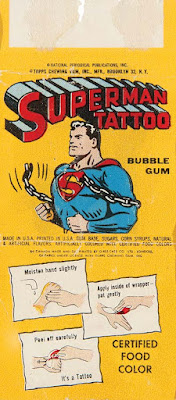There's a bit of an update to last year's NYE post regarding the 1960 Venezuelan Baseball Tattoo issue, thanks to Josh Alpert, who is the foremost collector and chronicler of the 1959-68 efforts Topps made in that country. He's offered his take on the set, as it's comprised so far at least, and his comments are illuminating. He's also provided scans of the other eight known players, which I will show below his comments.
As to the roster of US players, Josh says: "I would imagine they originally produced all the stars - Mantle, Mays, Koufax, but my guess is they are all long gone.
The timing of the issue is probably 1960, with this as part of his reasoning: "Colavito was traded to Detroit April 17, 1960. If they were a 1961 issue, I would think he’d have been drawn in Detroit colors, not Cleveland’s."
Josh also had a very interesting observation as to the scarcity and packaging: "In the US, the tattoos were sold as a stand alone product with a piece of gum. The Venezuelans almost certainly didn't have the machinery to mechanically package the tattoo around a piece of gum. I think this explains the smaller size of the tattoo, it corresponded with the size of a piece of gum, and they were packaged with a piece of gum (as they advertise), probably wrapped in cello and sold individually. This seems more plausible to me and helps explain the extreme scarcity. Almost no one would have kept them if they came with a piece of gum. Someone buying a single piece of gum would have likely opened the gum on the spot and either thrown away the wrapper and tattoo, applied the tattoo, or used the tattoo for the spent gum. They don't have nearly the collectability as the cards, it's likely no one even gave it a thought to collect them- except at least one person, clearly, who collected them intentionally and saved a small handful that we know of."
And now, the new/old scans:
Bob Allison won the 1959 American League Rookie of the Year voting as a member of the old Washington Senators. He's not thought of as a big star today but he certainly was during the first half of his career. Note there is no
production rip in the tattoo, unlike the American versions.
Amaro presents a bit of a conundrum. The Tatoo set was produced in Venezuela but he was Mexican and played in that county during his winter ball days. Mexico wasn't even a participant in the CWS until 1970 but as it turns out, from 1961 to 1969 there was no Caribbean World Series after Castro dissolved all the professional Cuban leagues in 1961. Amaro is one of the three known players to only appear in the Venezuelan Tatoo set. His inclusion is curious if the set was only marketed in Venezuela but there's no evidence of any other country being involved in the distribution.
Another big name at the time, Colavito's Cleveland colors prevailed, per Mr, Alpert, despite his trade to Detroit at the start of the 1960 MLB season. Topps being Topps, even if the set was issued after the 1960 Major League season ended, the colors may have been left alone. But going with the year of U.S. issue seems apt as well.
Drysdale made his first MLB All star team in 1959, so was a solid choice. The staining and unique paper loss along the bottom right edge match up almost exactly to the Allison example above.
Fox was another well known player who had a fabulous 1959 season that led to the AL MVP award. Total no brainer.
Killebrew finally put things together in 1959, so the set ended up with two Senators players!
His nickname was the "Dominican Dandy" so it's pretty clear where Juan Marichal pitched in winter ball. As pointed out in the
original post, Luis Arroyo, the third non-U.S. checklisted player in the set, pitched for Puerto Rico. I would expect some Venezuelan League subjects were included in the set but so far none have surfaced.
Another no brainer for inclusion to my mind, Mathews was destroying MLB pitching season-after-season by the time 1960 rolled around.
Hopefully an Early Wynn scan will pop up soon. Josh Alpert has just advised a Vic Power has now shown up, so he's a second Puerto Rican born player that was not in the U.S. set and some other subjects have just been identified as well, too late for this post (watch this space).
Here is the latest checklist then, 11 in number and I have been advised they generally measure 1 3/16" x 2 1/4", which is smaller than the U.S. version's dimensions of 1 9/16" x 3 1/2", with some variance in the size possible:
Bob Allison
Ruben Amaro (Venezuelan only)
Luis Arroyo (Venezuelan only)
Rocky Colavito
Don Drysdale
Nellie Fox
Harmon Killebrew
Juan Marichal (Venezuelan only)
Ed Mathews
Vic Power (Venezuelan only)
Early Wynn (photo seen, not the tatoo)
You can take this link with a heaping amount of salt as it's from Wikipedia, but it details MLB players who have appeared in the Caribbean World Series, although far more played in the various Winter Leagues. There's a lot more to be uncovered regarding the Venezuelan Tattoo sets but it's just part of a larger history that's still revealing itself.
I'll keep updating as more information comes in.























